Ninety years ago, the proprietor of 怡珍茶樓 (Yee Zhen tea house) at the Five Phoenix Village 五鳳鄉 in Guangzhou created Har Gow (shrimp dumpling). He combined the shrimp, bamboo shoots, and pork fat and made a dumpling with the rice flour pastry. He named this delicacy the Five Phoenix dumpling.
Later, other chefs improvised the dumpling wrappers using wheat starch to form a thinner and more delicate dumpling skin. This delicacy has fast become famous in Guangzhou due to its unique presentation and flavor.
Ninety years later, it has evolved into one of the most recognizable Cantonese dim sum, Har Gow.
In this article, I will show you how to make Har Gow (shrimp dumplings) from scratch. It only involves some basic ingredients and can be done easily at home.

The Yam Cha culture
Har Gow (or Chinese prawn dumpling) is one of the old-school Cantonese Dim Sum classics served during ‘Yam Cha”, the time-honored Cantonese version of breakfast tea. The chef showcases his culinary craftsmanship by creating multiple pleats on the Har Gow. The Dim Sum lady will load the Har Gow on the trolley and skillfully trundle through the narrow gaps between the marble tables and wooden chairs in a small shop.
Har Gow is the transliteration of the Chinese term 蝦餃, which means shrimp dumpling. Shumai and Char Siu Bao also form the triumvirate of the world-famous Cantonese Dim Sum. Har Gow is by far the most artistry, with the bright pink chunks of fresh shrimp veiled through the thin, stretchy, chewy, delicate, and translucent wrapper.
Shrimp dumpling is the most recognizable Cantonese dim sum. It has crystal clear, translucent, and chewy skin with either chopped or whole shrimp encased. Hence, some dim sum restaurants call it crystal shrimp dumplings. It is a bite-size delicacy, much like sushi. You will experience the shrimp juice oozing out when you bite the best shrimp dumpling.
The key ingredients are shrimp, pork fat, and bamboo shoots, with the modern variation of only using fresh whole shrimp, which is more flavorful and crunchy.
Dim Sum’s master chefs can artistically fold eight to thirteen pleats imprinted on its wrapper. This masterful delicacy is called the king of Har Gow or crystal-skinned shrimp dumplings.
This staple of Cantonese tradition looks simple, but many people hesitate to make it at home due to the technique involved. In addition, you need some practice on how to pleat the dumplings, although the presentation does not affect the taste of Har Gow.
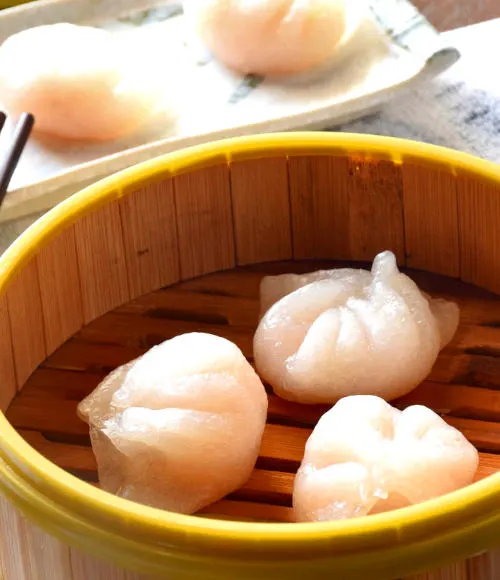
A step-by-step guide to making the best Har Gow
1. What are the best ingredients for the wrapper?
There is no consensus on the wrapper’s formula. Most recipes include wheat, corn, tapioca starch, and oil. I have done a series of tests to find the best wheat starch and tapioca starch ratio. The ratios are based on the recipe by well-known food bloggers and renowned Dim Sum master chefs.
The criterion is to have stretchable shrimp dumpling wrappers that can roll to an ultra-thin, translucent dough.
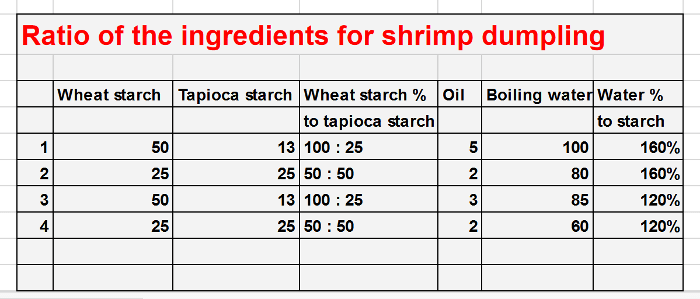
The result showed that recipe number 2 yielded the best result. The Har Gow skin is elastic, stretchable, and can roll out thinly without breakage. The amount of water is just sufficient to make it pliable and easy to wrap the filling.
You can adjust the amount of the ingredients in my recipe if the skin turns out to be less desirable. The result varies with the quality of the wheat starch and the use of potato starch or cornstarch.
Tips and suggestions:
- Reduce the amount of starch if the skin is too chewy.
- Adjust the amount of the boiling water if necessary until it is not too wet and easy to roll out. You may not need to change the quantity of the water in most cases, but sometimes the quality of the wheat starch differs, and adjustment may be required.
- Add a small amount of oil (either vegetable oil or lard) to the dough to make it softer and stretchable.
2. How to prepare the wrapper dough for the best result
Mix the wheat starch, tapioca starch, and salt in a mixing bowl. Add the boiling water and stir the flour vigorously until it forms a sticky dough. Then add a small amount of oil, and knead it until it is smooth, pliable, and homogeneous.
Anyone who knows how to make bread will understand this process. However, there are a few points you want to take note of to ensure it turns out perfectly:
Tips and suggestions:
- When making the dough, you must use hot water, preferably boiling water.
- The water should be sufficient to form a soft, malleable dough. If the dough cracks when you roll it out, you need to increase the quantity of water. (More information about this is in the following sections).
- I used vegetable oil for my recipe, but you can use lard as a substitute.
3. The optimum amount of water for the dough
When making the shrimp dumpling wrapper for the first time, you may find that the boiling water varies significantly from recipe to recipe. For example, chef 孙志强 uses only half the amount of boiling water compared to the total amount of starch, while blogger Wantanmian uses much more water than other chefs.
Why is there such a significant disparity in the quantity?
This is likely due to the different quality of the wheat starch. In addition, experienced Dim Sum chefs develop ‘hand-feel”, which means they can know whether the dough is moist enough by touching and kneading it.
Since this type of ‘feel” can only develop through experience, the following guideline is helpful to anyone new to making the shrimp dumpling wrapper:
Tips and suggestions:
The piece of dough is too dry if:
- The dough cracks at the side when you roll it into a circle.
- Hard to roll it to paper-thin.
- It tears when you wrap the filling halfway.
The dough is too wet if:
- It is sticky.
Either way, you can add a small amount of wheat starch to the dough if it is too wet or add some boiling water if it is too dry. After that, knead it again until it is smooth and even.
Let the dough relax for five minutes before cutting it into small pieces.
4. How to roll out the wrapper
I think spreading the dough to paper-thin with the back of the Chinese cleaver is more efficient than by the rolling pin.
Here are the steps:
- Roll the dough into a long cylinder. Cut it into equal pieces of 12g to 15g each. (You may want to start with 15g first, as it is easier to fold the large than the small one.)
- Keep the dough balls in a container with a cover, or leave them in a bowl and cover with a damp cloth to prevent them from drying.
- Apply some oil with a brush to the side of the knife to press and spread the dough into a thin, round layer. The oil will prevent the dough from sticking to the knife. You can apply more oil to the knife (and the surface of the dough) if the dough sticks to the knife as you drag and spread the dough into a thin layer. Oil works much better than flour and is the standard practice of chefs.
- Roll out the dough to a round shape, And one half should be thinner than the other. The thicker side is the base of the dumpling, and the other is for making delicate folds that reveal the shrimp inside the dumplings.
If this is too difficult, you can use the rolling pin to roll out the dumpling wrapper, just like making pastry. I think many people who have made pastry will find it easier to do it with the rolling pin.
5. How to fold the dumpling
There is no fixed method to fold the dumpling. An easy way for one person may be difficult for others.
I use simple methods to pleat the dumpling in the video. However, wrapping the dumpling is the tricky part of making shrimp dumplings for most people.
Here is the method:
Hold the dumpling skin in your hand and place the filling off-center, slightly towards the thicker side of the dumpling. Next, pleat the dumpling by pushing the dumpling skin with the index finger of one hand and pressing to secure the pleat with the index finger of another hand. (Ahh! It’s hard to explain, so please watch the video on this page!)
Tips for wrapping the Har Gow
The following points are applicable regardless of how you want to fold them.
- Place the shrimp filling slightly off-center and closer to the thicker part of the dumpling skin. This placing of the filling allows more area of the wrapper for pleating.
- A bigger dumpling is easier to make than a small one.
- Create a loose cavity to hold the filling to prevent the skin from tearing due to the expansion of the shrimp during steaming.

6. The best ingredients for the dumpling filling
The main ingredients for the filling consist of shrimp, bamboo shoots, and pork fat. The seasoning consists of oil, ground white pepper, sesame oil, salt, and sugar. Some recipe includes a small amount of oyster sauce, minced garlic, and chopped ginger. All you need is to mix everything thoroughly in a large bowl.
I prefer to keep the seasoning light and simple and let the flavor of the shrimp shine.
My recipe consists of coarsely chopped shrimp plus whole shrimp and bamboo shoots. I have omitted the pork fat for health reasons.
Here are the steps:
- Marinating the shrimp in a baking soda solution for twenty minutes is the secret to getting plump shrimp. Baking soda (some chefs use lye water) increases the shrimp’s pH and helps retain the moisture as it cooks. If you do not think plump shrimp is important, you may use salt to marinate the shrimp, as in this har gow recipe. However, omitting this step will get the same taste and flavor.
- Marinating the shrimp with salt will make it more crunchy.
- If you like to include some pork fat in the recipe (I am just happy with shrimp and bamboo shoots), cut the pork fat and blanch it in boiling water briefly until it is just cooked. Then, transfer it to cold water and soak it until it returns to room temperature. This simple treatment of pork fat can make it less greasy.
- You can double up the number of bamboo shoots if you want to omit the pork fat.
- Keep the filling in the refrigerator for at least 30 minutes before proceeding to wrap. The cold filling is easier to wrap into the wrapper.
7. How to steam the shrimp dumplings
Here are the steps:
- Steam for six minutes over high heat, lid on.
- You can place the shrimp dumpling directly in the bamboo steamer basket or by lining it with baking paper, parchment paper, or cheesecloth. Apply some oil to prevent it from sticking. After steaming, the dumplings are pretty sticky and can stick to the unoiled surface.
- Shrimp dumplings are best served while it is hot, immediately after steaming. That is why Dim Sum stores will steam the shrimp dumplings upon order.
- Deep freeze the uncooked shrimp dumplings if you do not intend to steam them immediately. You can steam the frozen shrimp dumplings just like the fresh one, but steam for an extra minute to ensure it cooks through.
Update 2023
Here is the list of useful information based on my readers’ comments, both in this post and on the YouTube channel.
Storage :
You can make the shrimp dumplings ahead of time. After you have made the har gaw, you can place them in a container and put them in the freezer. Ensure they are not touching each other to prevent them from sticking together.
When you want to steam them, you steam directly from the frozen state, but just a little longer. Most Dim Sum restaurants do that!
How to roll out the dough:
Some people find that it is not easy to roll the dough very thinly by using the traditional method of pressing the dough with the side of a cleaver; try these two methods which my readers use:
- Roll the dough between two plastic sheets with a small rolling pin. The plastic sheets will prevent the dough from sticking to the rolling pin. I use the same technique to roll my Chinese egg tart pastry. You can check out this recipe on my blog too.
- Use a tortilla press to make the dough. Not only does it roll out flat, but it is also quicker and easier than using the chef’s cleaver.
Substitute for wheat starch:
I am afraid there is no suitable substitute for wheat starch for the skin of these steamed prawn dumplings, as it is the primary ingredient for the pastry. You can, however, try to get it from any Asian grocery shop. Wheat starch is 澄麵粉. Show these three Chinese characters to the shopkeeper. I hope this can help you to get it. You can also get it online from Amazon.
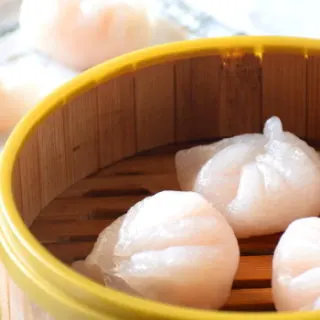
How to make the best Har Gow (蝦餃)
Shrimp dumpling is one of the most famous Cantonese dim sum available.
Ingredients
The dough
- 50 g wheat starch
- 50 g tapioca starch
- 1/2 g salt
- 1/4 teaspoon vegetable oil
- 160 ml boiling water
The filling
- 500 g prawns, Weigh before cleaning, then peeled, deveined, and patted dry
- 50 g bamboo shoot, finely chopped
- 2 teaspoons salt
- 5 g sugar
- 5 g corn starch
- 1/4 teaspoon ground white pepper
- 1 tablespoon Shaoxing wine
- 2 teaspoons sesame oil
Instructions
The dough
- Mix the wheat starch, tapioca starch, and salt in a mixing bowl.
- Add the boiling water into the mixing bowl. Stir the mixture vigorously until it looks like snowflakes.
- Add the oil.
- Knead the dough until soft and pliable.
- Cover it and let it relax for 5 minutes.
- Put it on a work surface and roll it into long strips.
- Cut dough into small portions, 15-20g each.
- Roll out the dough, and wrap the shrimp filling with the wrapper.
The filling
- Clean and devein the shrimps. Marinate with salt for 5 minutes and wash thoroughly under running water.
- Chop the shrimp coarsely.
- Chop the bamboo shoots into small pieces.
- Mix the shrimps, bamboo shoots, and the seasoning until it becomes sticky.
To steam
- Place the dumplings in the bamboo steamer.
- Steam for 6 minutes.
- Serve immediately.
Notes
The weight for the shrimp in the recipe weight around 300 g of shrimp meat.
Recommended Products
As an Amazon Associate and member of other affiliate programs, I earn from qualifying purchases.
Nutrition Information:
Yield: 15 Serving Size: 15 dumplingsAmount Per Serving: Calories: 74Total Fat: 1gSaturated Fat: 0gTrans Fat: 0gUnsaturated Fat: 1gCholesterol: 70mgSodium: 611mgCarbohydrates: 7gFiber: 0gSugar: 1gProtein: 8g
This data was provided and calculated by Nutritionix on 5/29/2019
Reference
1. Har Gow (Dim Sum Shrimp Dumplings)
2. Food of China Paperback – May 1, 2009, by Kay Halsey (Author)
3. Har Gow (Chinese Shrimp Dumplings) Recipe
4. Dim Sum Classics: How to Make Crystal Skin Shrimp Dumplings (Har Gow)
5. Wantanmien
6. 超多图示范在家怎样做出一品虾饺皇
7. 蝦餃之王 蜘蛛肚彈牙爆汁

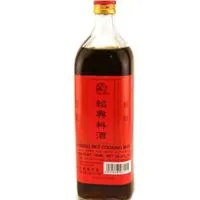
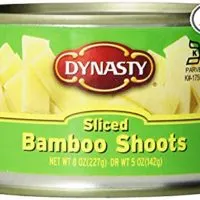
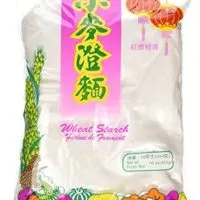

Kung Pao Shrimp Recipe (宫保虾球) - Easy Chinese Stir-fry
Saturday 19th of July 2025
[…] optional step that makes the shrimp crunchy. It is also used when preparing shrimp dumplings (Har Gow, a renowned Dim Sum dish) when a crunchy shrimp texture is […]
Rita
Wednesday 12th of April 2023
Fantastic recipe with great instructions and video. Your 50/50 starch worked best for me. I tried another recipe that was 100 wheat 25 tapioca, difficult to work with and fell apart when cooked. I did have to reduce the water. 160ml is too much for the type of starch I used. THANK YOU.
Rick
Monday 2nd of August 2021
First, I appreciate the time and effort you put into researching the recipes you present, how others do parts of the recipe differently, etc. Makes your presentations look like a labour of love, looking for something that most people can do in their homes. Well done sir, I stumbled into your YouTube/Website and now I'll be lurking and checking every recipe out for days!
I do have a generic question to recipes that include using pork fat and/or pork belly. I don't mind eating either of them in the slightest. But finding them to buy around here in this very small town is difficult. Not impossible, but difficult - you have to plan ahead and wait until it is available.
With that in mind, and your obvious experimenting, are there makeshift substitutes for pork fat when you don't have it? I'm thinking of substituting lard by weight (or volume perhaps), although it's obvious one disadvantage is that lard would add nothing to the texture. Whether that's a big deal or not, I don't know.
Any suggestions for an amateur in a town where the nearest supermarket is an hour away, sir?
KP Kwan
Tuesday 3rd of August 2021
Hi Rick, I agree that lard is not the best substitute for pork fat because it lacks texture. It is not a big deal if you use only lean meat for cooking, without the fat part. It is healthier but can be a little dry. Next time when you buy the pork fat, cut it into small portions and keep it in your freezer. It should store well for months. Then, just take out one portion whenever you need it and save your trip to get it again. Thanks, KP Kwan
Emily
Monday 15th of March 2021
Hi i noticed you mentioned that to store/freeze the dumpling, not to have them touch. I tried the recipe and things turned out perfectly accept after steaming the skin is so sticky it sticks to the base of the bamboo steamer and tear away when I removed them. Is there any way to make them less sticky after steaming? The dough I made seem just right. not too sticky not too dry. It's just after the steaming that is the problem.
KP Kwan
Wednesday 17th of March 2021
I have not encountered such a problem, perhaps because I used the nonstick baking paper. You may oil the normal baking paper first before putting the dumplings, and I hope it will work.
LEi
Thursday 14th of January 2021
Hi Thanks for the recipe, i was so craving for this dumpling, ive been buying from the Dumpling resto but its not cheap here in Australia so I decided to make my Own. And I found this page. I made your recipe and I can say its an Authentic Recipe. So everything was almost perfect however, I got caught in a very sticky situation when I used both tapioca and Potato Starch instead of Wheat Starch Ive been rolling for 2 hours because the dough was stickingon the board and onto my rolling pin, and they were heaps chewy. But Im pretty sure i am going to make them again once I got a Proper WHeat Starch. Thanks so much for sharing. ❤️
KP Kwan
Thursday 14th of January 2021
Thank you for trying the recipe, and I wish you can get the ingredients you need in Australia.